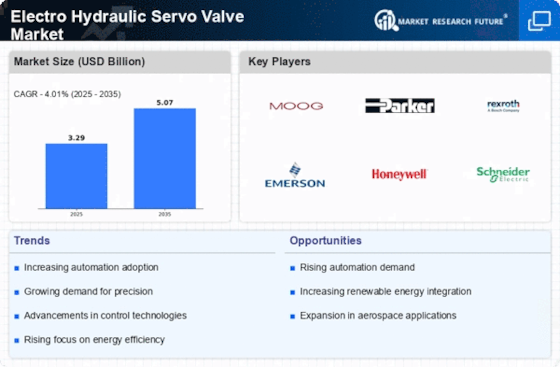Growth in Renewable Energy Sector
The Electro Hydraulic Servo Valve Market is also benefiting from the growth in the renewable energy sector. As countries strive to transition towards sustainable energy sources, the demand for efficient hydraulic systems in wind turbines and solar power plants is increasing. Electro hydraulic servo valves play a crucial role in optimizing the performance of these systems, ensuring reliable operation under varying conditions. Recent statistics indicate that the renewable energy sector is expected to grow at a CAGR of approximately 8% over the next decade, which could significantly impact the Electro Hydraulic Servo Valve Market. This growth presents opportunities for manufacturers to innovate and develop specialized products tailored to the unique requirements of renewable energy applications.
Expansion in Industrial Automation
The Electro Hydraulic Servo Valve Market is poised for growth due to the rapid expansion of industrial automation. As industries increasingly adopt automation technologies to enhance productivity and efficiency, the demand for precise control systems, including electro hydraulic servo valves, is likely to rise. The manufacturing sector, particularly in regions with a strong industrial base, is expected to witness a significant uptick in the adoption of these valves. Market data suggests that the industrial automation sector is projected to grow at a CAGR of around 6.5% in the coming years, further driving the need for advanced control solutions. This trend underscores the importance of the Electro Hydraulic Servo Valve Market in facilitating the transition towards more automated and efficient manufacturing processes.
Rising Demand in Aerospace and Defense
The Electro Hydraulic Servo Valve Market is experiencing a notable surge in demand, particularly within the aerospace and defense sectors. This growth is primarily driven by the increasing need for precision control in aircraft and military applications. As defense budgets expand, investments in advanced technologies are prioritized, leading to a higher adoption of electro hydraulic servo valves. According to recent data, the aerospace sector alone is projected to account for a significant share of the market, with a compound annual growth rate (CAGR) of approximately 5.2% over the next five years. This trend indicates a robust future for the Electro Hydraulic Servo Valve Market, as manufacturers strive to meet the stringent requirements for reliability and performance in critical applications.
Increasing Focus on Safety and Compliance
The Electro Hydraulic Servo Valve Market is witnessing an increasing focus on safety and compliance standards across various sectors. As industries face stricter regulations regarding operational safety and environmental impact, the demand for reliable and compliant hydraulic systems is growing. Electro hydraulic servo valves are essential components in ensuring that systems operate within safety parameters, thereby reducing the risk of accidents and failures. Recent data suggests that industries such as oil and gas, manufacturing, and transportation are prioritizing investments in safety-compliant technologies, which is likely to drive the demand for electro hydraulic servo valves. This trend indicates a promising outlook for the Electro Hydraulic Servo Valve Market as companies seek to enhance safety and meet regulatory requirements.
Technological Advancements in Valve Design
Technological advancements in valve design are significantly influencing the Electro Hydraulic Servo Valve Market. Innovations such as the integration of smart technologies and improved materials are enhancing the performance and reliability of electro hydraulic servo valves. These advancements allow for better responsiveness and control, which are essential in high-performance applications. Furthermore, the introduction of digital control systems is enabling more precise operation, which is increasingly demanded in various sectors, including automotive and aerospace. Market analysis indicates that the adoption of advanced valve technologies could lead to a market growth rate of around 7% in the coming years, highlighting the critical role of innovation in shaping the Electro Hydraulic Servo Valve Market.


















Leave a Comment